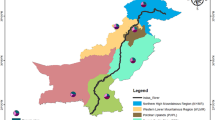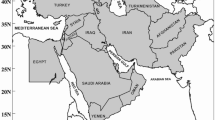Conclusions
Three observations can be made. First,P. oleracea andM. verticillata were present in temperate eastern North America 2500-3000 years ago.
Second, the intimate association of purslane and carpetweed with human activities leads us to speculate that the spread of these weeds was in part due to the American Indian. It is likely that purslane occurred in the same plots where the Salts Cave inhabitants cultivated sunflower (Helianthus annuus), sumpweed (Iva annua), chenopod (Chenopodium sp.), squash (Cucurbita pepo), and gourd (Lagenaria siceraria).
Third, the identifications of these two species emphasizes the potential and the need for cooperation between scientists in various disciplines. Paleoethnobotany can contribute much to the understanding of plant histories and their relationships to man.
Similar content being viewed by others
Literature Cited
Watson, P. J. 1969. The prehistory of Salts Cave, Kentucky. Reports of Investigations, No. 16. Illinois State Museum, Springfield.
Watson, P. J. (Ed.). 1974. Archaeology of the Mammoth Cave Area. Academic Press, N.Y.
Gleeson, P. F. (Ed.). 1970. Archaeological investigations in the Tellico reservoir, interim report, 1970. Report of Investigations, No. 9. Department of Anthropology, University of Tennessee, Knoxville.
Chapman, J. 1973. The Icehouse Bottom Site—40 Mr 23. Report of Investigations, No. 13. Department of Anthropology, University of Tennessee, Knoxville.
Walker, W. M. 1936. The Troyville Mounds, Catahoula Parish, Louisiana. Bureau of American Ethnology, Bulletin 113.
de Candolle, A. 1886. Origin of Cultivated Plants, 2nd ed. Kegan Paul, Trench, & Co., London.
Fernald, M. L. 1950. Gray’s Manual of Botany, 8th ed. American Book Company.
Frankton, C. 1955. Weeds of Canada. Botany and Plant Pathology Div., Science Service, Canada Department of Agriculture, Ottawa.
Small, J. K. 1913. Flora of the Southeastern United States, 2nd ed. Published by the author, N. Y.
U. S. Department of Agriculture. 1970. Selected Weeds of the United States. Agriculture Handbook No. 366.
U. S. Department of Agriculture. 1971. Common Weeds of the United States. Agriculture Research Service, Dover.
Bogle, A. L. 1969. The genera ofPortulacaceae andBasellaceae in the southeastern United States. J. of Arnold Arboretum50(4): 566–598.
Kaplan, L. 1971. Archaeology and domestication in American Phaseolus (Beans). In Stuart Struever, Prehistoric Agriculture. The Natural History Press, p. 516–533.
Marie-Victorin, F. 1964. Flore Laurentienne. University of Montreal Press.
Bogle, A. L. 1970. The genera ofMolluginaceae andAizoaceae in the southeastern United States. J. of Arnold Arboretum51(4): 431–462.
Author information
Authors and Affiliations
Rights and permissions
About this article
Cite this article
Chapman, J., Stewart, R.B. & Yarnell, R.A. Archaeological evidence for precolumbian introduction of portulaca oleracea and mollugo verticillata into Eastern North America. Econ Bot 28, 411–412 (1973). https://doi.org/10.1007/BF02862857
Received:
Issue Date:
DOI: https://doi.org/10.1007/BF02862857




